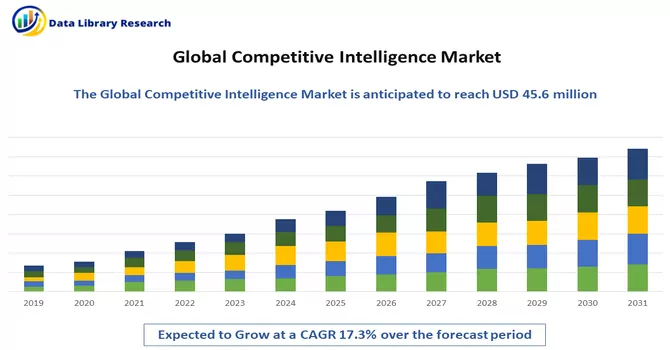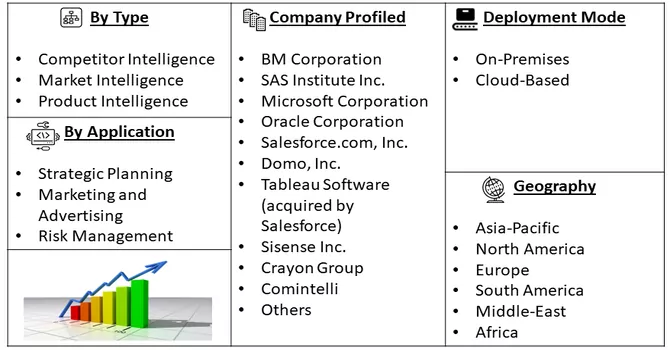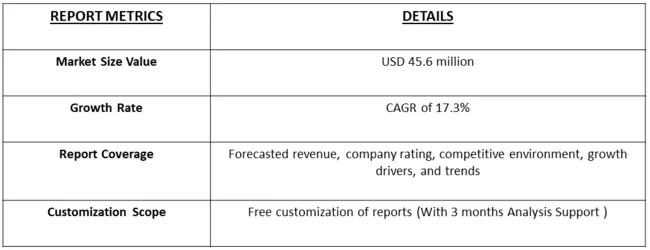The global competitive intelligence tools market size was valued at USD 45.6 million in 2023 and exhibited a CAGR of 17.3% during the forecast period, 2024-2031.

Get Complete Analysis Of The Report - Download Free Sample PDF
Competitive intelligence is the systematic process of gathering, analyzing, and interpreting information about competitors, market trends, and industry dynamics to inform strategic decision-making within a business. It involves the collection of data from various sources, such as public records, market reports, competitor communications, and industry events, to gain insights into competitors' strengths, weaknesses, opportunities, and threats. The objective is to provide organizations with a deeper understanding of their competitive landscape, enabling them to anticipate market changes, identify potential risks, and formulate effective strategies to gain a competitive advantage. Competitive intelligence plays a crucial role in enhancing business competitiveness, facilitating informed decision-making, and adapting to the dynamic nature of the market.
A pivotal growth-driving factor for competitive intelligence lies in its capacity to provide businesses with a strategic advantage through informed decision-making. By systematically gathering and analyzing data on competitors, market trends, and industry dynamics, organizations gain valuable insights that enable them to identify opportunities, anticipate challenges, and make well-informed strategic choices. The ability to stay ahead of market changes, understand consumer preferences, and assess competitor actions positions businesses to respond effectively, enhance their competitive positioning, and capitalize on emerging trends. As industries become more dynamic and competitive, the role of competitive intelligence as a key driver for sustained growth becomes increasingly indispensable for organizations striving to navigate and succeed in complex business environments.
The competitive intelligence market has witnessed dynamic trends, with a notable emphasis on real-time intelligence, integration of artificial intelligence and machine learning for enhanced data processing, and a heightened focus on cybersecurity intelligence to address digital threats. As businesses expand globally, there is a growing demand for insights into emerging markets and regulatory changes. The evolving regulatory landscape, strategic partnerships, and mergers have also shaped the industry, while customizable solutions with user-friendly interfaces cater to the specific needs of diverse industries. The market continues to evolve to meet the demands of an increasingly dynamic and competitive business environment, adapting to technological advancements and changes in global landscapes.
Market Segmentation: The Competitive Intelligence Market is Segmented by Type of Intelligence (Competitor Intelligence, Market Intelligence and Product Intelligence), Deployment Mode (On-Premises and Cloud-Based), Application (Strategic Planning, Marketing and Advertising and Risk Management) and Geography(North America, Europe, Asia-Pacific and Rest of the World). The report offers market size and forecasts in terms of value (USD million) for all the above segments.

For Detailed Market Segmentation - Download Free Sample PDF
Market Drivers:
Increasing Global Competition
The escalating competitiveness on a global scale across various industries is compelling businesses to allocate resources towards competitive intelligence initiatives. This strategic investment aims to acquire nuanced insights, discern prevailing market trends, and maintain a competitive edge amidst the swift evolution of the business landscape. By proactively engaging in competitive intelligence, companies position themselves to not only understand the strategic moves of their rivals but also to formulate informed strategies that align with dynamic market dynamics. The imperative to stay ahead in this fiercely competitive environment underscores the crucial role of competitive intelligence in guiding businesses towards effective decision-making and sustainable success.
Rising Complexity in Business Environments
The increasing intricacy of contemporary business landscapes, marked by advancements in technology, shifts in regulatory frameworks, and the dynamic nature of consumer behaviours, underscores the necessity for competitive intelligence. In this evolving scenario, businesses are actively pursuing extensive datasets to adeptly navigate through intricate challenges and arrive at well-informed decisions. The demand for competitive intelligence arises from the recognition that a comprehensive understanding of technological trends, compliance requirements, and changing consumer preferences is paramount for companies aiming to thrive in complex and multifaceted business environments. By leveraging competitive intelligence, businesses position themselves to not only comprehend the intricacies of their operating landscapes but also to proactively respond to emerging complexities with strategic acumen.
Market Restraints:
Data Privacy Concerns
The heightened regulatory scrutiny and growing apprehensions regarding data privacy present formidable challenges for providers of competitive intelligence. Effectively navigating this landscape requires a delicate equilibrium between accessing valuable information and adhering to stringent data protection regulations. This persistent obstacle necessitates that competitive intelligence providers not only stay abreast of evolving regulatory frameworks but also develop robust mechanisms to ensure compliance. Striking the right balance becomes crucial as organizations seek to glean meaningful insights while upholding the principles of data privacy, emphasizing the need for a nuanced and adaptable approach in the ever-evolving landscape of regulatory requirements.
Risk Management Segment is Expected to Witness Significant Growth Over the Forecast Period
Competitive intelligence tools play a crucial role in enhancing risk management strategies for businesses. By continuously monitoring and analyzing competitor activities, market trends, and regulatory changes, these tools provide organizations with valuable insights to identify and assess potential risks. This proactive approach allows businesses to anticipate challenges such as market disruptions, emerging competitive threats, or regulatory shifts. Competitive intelligence tools also help in evaluating the financial stability and operational capabilities of competitors, enabling companies to make informed decisions on risk mitigation and strategic positioning. Additionally, by tracking industry developments and customer sentiments, these tools contribute to a comprehensive risk assessment, guiding businesses in adapting their strategies to changing market dynamics. Overall, competitive intelligence tools act as a proactive risk management mechanism, equipping organizations with the necessary information to navigate uncertainties, make well-informed decisions, and enhance overall resilience in a dynamic business environment.
North America Region is Expected to Witness Significant Growth Over the Forecast Period
The North America region stands as a dynamic and pivotal hub for the competitive intelligence market, characterized by a robust adoption of advanced technologies and a highly competitive business landscape. With a strong emphasis on innovation and a proactive approach to market dynamics, North American businesses leverage competitive intelligence tools to gain strategic insights, monitor industry trends, and stay ahead of competitors. The region's diverse industries, including technology, healthcare, finance, and manufacturing, fuel the demand for comprehensive competitive intelligence solutions. The presence of key market players, coupled with a high awareness of the strategic importance of competitive intelligence, contributes to the market's growth. Moreover, North America's regulatory landscape and the emphasis on data-driven decision-making further drive the adoption of competitive intelligence tools. As businesses in the region navigate the complexities of a fast-paced market, the integration of sophisticated competitive intelligence solutions continues to be instrumental in maintaining a competitive edge, fostering innovation, and achieving sustainable growth.
The COVID-19 pandemic has exerted a significant impact on the competitive intelligence market, introducing both challenges and opportunities. The widespread disruptions to global supply chains, market dynamics, and consumer behaviors prompted businesses to intensify their focus on competitive intelligence to navigate uncertainties effectively. Industries such as healthcare experienced a surge in demand for competitive intelligence to monitor developments in vaccine research, regulatory changes, and supply chain disruptions. However, the pandemic also brought about limitations, such as delays in data collection and the difficulty of predicting long-term market trends amid unprecedented volatility. Remote working trends and digital acceleration, accelerated by the pandemic, underscored the importance of real-time and digital competitive intelligence solutions. Overall, the COVID-19 crisis emphasized the critical role of competitive intelligence in enabling businesses to adapt swiftly to dynamic circumstances, though it also underscored the need for increased flexibility and resilience in intelligence-gathering processes.
Segmental Analysis:
Product Intelligence Segment is Expected to Witness Significant Growth Over the Forecast Period
Product intelligence plays a pivotal role in the competitive intelligence market, offering multifaceted advantages to businesses. By providing in-depth insights into market demands, customer preferences, and competitor landscapes, product intelligence empowers organizations to make informed decisions. It facilitates informed product development, allowing businesses to align their offerings with market needs and innovate competitively. The ability to benchmark against competitors, optimize pricing strategies, and streamline supply chains enhances overall market positioning and operational efficiency. Moreover, product intelligence enables businesses to understand consumer sentiments, ensuring that marketing strategies resonate with target audiences and foster brand loyalty. By staying attuned to regulatory changes and mitigating potential risks, businesses can navigate challenges and maintain a proactive approach to innovation. In essence, product intelligence is a strategic tool that not only keeps businesses ahead of market trends but also guides them in creating products that stand out in an ever-evolving competitive landscape.
Cloud-Based Segment is Expected to Witness Significant Growth Over the Forecast Period
The adoption of cloud-based solutions in the competitive intelligence market offers a myriad of benefits, transforming the landscape for businesses. Cloud-based competitive intelligence platforms provide unparalleled scalability, allowing organizations to seamlessly expand their data storage and processing capabilities as their needs evolve. The accessibility and flexibility inherent in cloud solutions enable real-time collaboration and data sharing among diverse teams, fostering agility and enhancing decision-making processes. Additionally, cloud-based platforms reduce the burden of infrastructure management and maintenance, freeing up resources that can be redirected towards refining intelligence strategies and staying ahead of market trends. The cost-effectiveness of cloud deployment ensures that businesses, irrespective of size, can access cutting-edge competitive intelligence tools without substantial upfront investments, democratizing access to advanced analytics and insights. Overall, the cloud-based segment in the competitive intelligence market not only elevates operational efficiency but also democratizes access to powerful intelligence tools, driving innovation and strategic decision-making.

Get Complete Analysis Of The Report - Download Free Sample PDF
The analyzed market exhibits a high degree of fragmentation, primarily attributable to the presence of numerous players operating on both a global and regional scale. The competitive landscape is characterized by a diverse array of companies, each contributing to the overall market dynamics. This fragmentation arises from the existence of specialized solution providers, established industry players, and emerging entrants, all vying for market share. The diversity in market participants is underscored by the adoption of various strategies aimed at expanding the company presence. On a global scale, companies within the studied market are strategically positioning themselves through aggressive expansion initiatives. This often involves entering new geographical regions, targeting untapped markets, and establishing a robust global footprint. The pursuit of global expansion is driven by the recognition of diverse market opportunities and the desire to capitalize on emerging trends and demands across different regions. Simultaneously, at the regional level, companies are tailoring their approaches to align with local market dynamics. Regional players are leveraging their understanding of specific market nuances, regulatory environments, and consumer preferences to gain a competitive edge. This regional focus allows companies to cater to the unique needs of local clientele, fostering stronger market penetration. To navigate the complexities of the fragmented market, companies are implementing a range of strategies. These strategies include investments in research and development to stay at the forefront of technological advancements, mergers and acquisitions to consolidate market share, strategic partnerships for synergies, and innovation to differentiate products and services. The adoption of such multifaceted strategies reflects the competitive nature of the market, with participants continually seeking avenues for growth and sustainability. In essence, the high fragmentation in the studied market not only signifies the diversity of players but also underscores the dynamism and competitiveness that drive ongoing strategic maneuvers. As companies explore various avenues for expansion, the market continues to evolve, presenting both challenges and opportunities for industry stakeholders.
Some of the key market players working in this segment are:
Recent Development:
1) In January 2024, DelveInsight, a prominent firm specializing in pharmaceutical competitive intelligence and consulting solutions, introduces its innovative Pharma Competitive Intelligence Monitoring Services. This offering empowers clients to effortlessly track developmental assets, clinical trials, regulatory milestones, and commercial news, with the added advantage of receiving real-time high-priority alerts and assessing updates through an intuitive online dashboard. By providing such comprehensive and timely information, DelveInsight's services significantly contribute to the competitive intelligence market. Clients can gain a strategic edge by staying abreast of crucial developments in the pharmaceutical landscape, enabling them to make well-informed decisions, identify market trends, and navigate the competitive terrain effectively. This dynamic approach enhances the overall competitiveness of businesses operating in the pharmaceutical sector.
2) In February 2024, Aditude achieves a significant milestone in its ongoing commitment to empower publishers by introducing "Insights," a pivotal element within its advertising technology suite specifically designed for publishers. From its inception, Aditude has steadfastly dedicated itself to facilitating publishers in reaching their monetization goals and expanding their businesses by delivering cutting-edge technological solutions tailored to their unique requirements. With the launch of Insights, Aditude continues to reinforce its support for publishers, offering them valuable tools and analytics to optimize their advertising strategies, enhance monetization efforts, and navigate the evolving landscape of digital publishing with greater efficacy. This latest addition underscores Aditude's unwavering dedication to fostering the success of publishers through innovative and targeted technological advancements.
Q1. What was the Competitive Intelligence Market size in 2023?
As per Data Library Research the global competitive intelligence tools market size was valued at USD 45.6 million in 2023.
Q2. At what CAGR is the Competitive Intelligence market projected to grow within the forecast period?
Competitive Intelligence Market is exhibited a CAGR of 17.3% during the forecast period.
Q3. What are the factors driving the Competitive Intelligence Market?
Key factors that are driving the growth include the Increasing Global Competition and Rising Complexity in Business Environments.
Q4. hich region has the largest share of the Competitive Intelligence Market? What are the largest region's market size and growth rate?
North America has the largest share of the market. For detailed insights on the largest region's market size and growth rate request a sample here.
Data Library Research are conducted by industry experts who offer insight on industry structure, market segmentations technology assessment and competitive landscape (CL), and penetration, as well as on emerging trends. Their analysis is based on primary interviews (~ 80%) and secondary research (~ 20%) as well as years of professional expertise in their respective industries. Adding to this, by analysing historical trends and current market positions, our analysts predict where the market will be headed for the next five years. Furthermore, the varying trends of segment & categories geographically presented are also studied and the estimated based on the primary & secondary research.
In this particular report from the supply side Data Library Research has conducted primary surveys (interviews) with the key level executives (VP, CEO’s, Marketing Director, Business Development Manager and SOFT) of the companies that active & prominent as well as the midsized organization
FIGURE 1: DLR RESEARH PROCESS

Extensive primary research was conducted to gain a deeper insight of the market and industry performance. The analysis is based on both primary and secondary research as well as years of professional expertise in the respective industries.
In addition to analysing current and historical trends, our analysts predict where the market is headed over the next five years.
It varies by segment for these categories geographically presented in the list of market tables. Speaking about this particular report we have conducted primary surveys (interviews) with the key level executives (VP, CEO’s, Marketing Director, Business Development Manager and many more) of the major players active in the market.
Secondary ResearchSecondary research was mainly used to collect and identify information useful for the extensive, technical, market-oriented, and Friend’s study of the Global Extra Neutral Alcohol. It was also used to obtain key information about major players, market classification and segmentation according to the industry trends, geographical markets, and developments related to the market and technology perspectives. For this study, analysts have gathered information from various credible sources, such as annual reports, sec filings, journals, white papers, SOFT presentations, and company web sites.
Market Size EstimationBoth, top-down and bottom-up approaches were used to estimate and validate the size of the Global market and to estimate the size of various other dependent submarkets in the overall Extra Neutral Alcohol. The key players in the market were identified through secondary research and their market contributions in the respective geographies were determined through primary and secondary research.
Forecast Model
